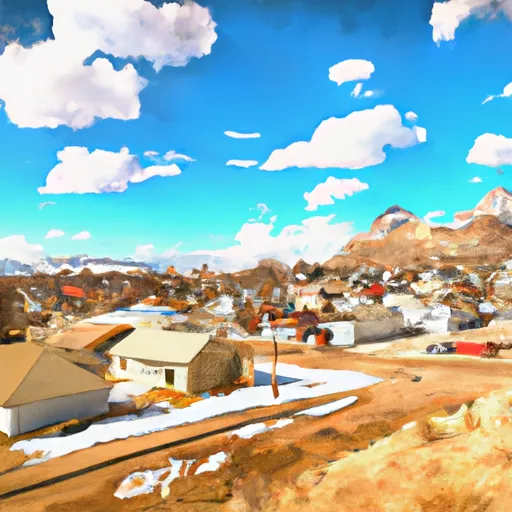-
 Snoflo Premium
Snoflo Premium
Get unlimited access to all our content
With no Ad interruptions! - Start Your Free Trial Login with existing account
Neola
Eden Index
Climate
7.3
•
Recreation
2.0
•
Community
0.8
•
Safeguard
3.8/10

Neola, Utah is a small, rural community located in the northeastern corner of the state. The climate in Neola is considered continental, with warm summers and cold winters. Summers are typically mild with temperatures reaching the mid-80s Fahrenheit, while winters can be cold with temperatures dropping below freezing. Precipitation is relatively low throughout the year, with most of it occurring in the form of snow during winter months.
Neola is surrounded by stunning natural landscapes and offers various outdoor recreation opportunities. The area boasts beautiful mountains, pristine forests, and several lakes and rivers. Fishing enthusiasts can enjoy angling for trout, bass, and other fish species in nearby waters such as the Uinta River and Mirror Lake. Hiking, camping, and wildlife viewing are popular activities in the surrounding Uinta Mountains, providing opportunities to explore the breathtaking scenery and encounter native wildlife.
In terms of hydrology constituents, the area is mostly dependent on local surface water sources, including streams and reservoirs, for irrigation and domestic purposes. Groundwater resources are limited, and residents rely on local entities for their water supply. Overall, Neola offers residents and visitors a chance to immerse themselves in nature and enjoy a range of outdoor activities amid a picturesque setting.
What is the Eden Index?
The Snoflo Eden Index serves as a comprehensive rating system for regions, evaluating their desirability through a holistic assessment of climate health, outdoor recreation opportunities, and natural disaster risk, acknowledging the profound impact of these factors on livability and well-being.
Climate Health Indicator (CHI): 7.3
Neola receives approximately
255mm of rain per year,
with humidity levels near 69%
and air temperatures averaging around
8°C.
Neola has a plant hardyness factor of
5, meaning
plants and agriculture in this region thrive during a short period during spring and early summer. Most
plants will die off during the colder winter months.
By considering the ideal temperature range, reliable water supplies, clean air, and stable seasonal rain or snowpacks, the Climate Health Indicator (CHI) underscores the significance of a healthy climate as the foundation for quality living.
A healthy climate is paramount for ensuring a high quality of life and livability in a region, fostering both physical well-being and environmental harmony. This can be characterized by ideal temperatures, reliable access to water supplies, clean air, and consistent seasonal rain or snowpacks.
Weather Forecast
Streamflow Conditions
Lower Green
Area Rivers
Lower Green
Snowpack Depths
Lower Green
Reservoir Storage Capacity
Lower Green
Groundwater Levels
Recreational Opportunity Index (ROI): 2.0
The Recreational Opportunity Index (ROI) recognizes the value of outdoor recreational options, such as parks, hiking trails, camping sites, and fishing spots, while acknowledging that climate plays a pivotal role in ensuring the comfort and consistency of these experiences.
Access to outdoor recreational opportunities, encompassing activities such as parks, hiking, camping, and fishing, is crucial for overall well-being, and the climate plays a pivotal role in enabling and enhancing these experiences, ensuring that individuals can engage in nature-based activities comfortably and consistently.
Camping Areas
| Campground | Campsites | Reservations | Toilets | Showers | Elevation |
|---|---|---|---|---|---|
| Hoop Lake | 44 | 9,227 ft |
Nearby Ski Areas
Catastrophe Safeguard Index (CSI):
The Catastrophe Safeguard Index (CSI) recognizes that natural disaster risk, encompassing floods, fires, hurricanes, and tornadoes, can drastically affect safety and the overall appeal of an area.
The level of natural disaster risk in a region significantly affects safety and the overall livability, with climate change amplifying these risks by potentially increasing the frequency and intensity of events like floods, fires, hurricanes, and tornadoes, thereby posing substantial challenges to community resilience and well-being.
Community Resilience Indicator (CRI): 0.8
The Community Resilience Indicator (CRI) recognizes that education, healthcare, and socioeconomics are crucial to the well-being of a region. The CRI acknowledges the profound impact of these elements on residents' overall quality of life. By evaluating educational resources, healthcare accessibility, and economic inclusivity, the index captures the essential aspects that contribute to a thriving community, fostering resident satisfaction, equity, and social cohesion.

